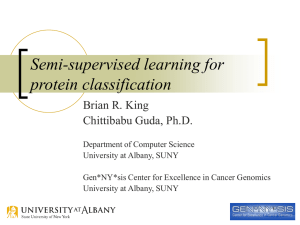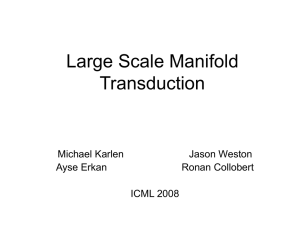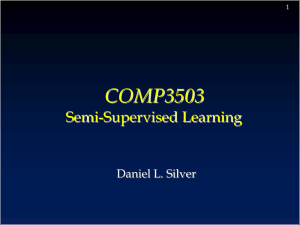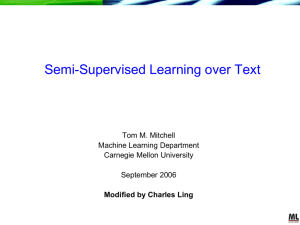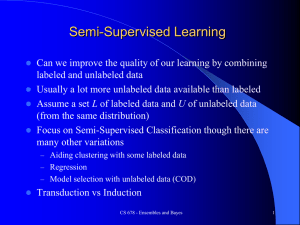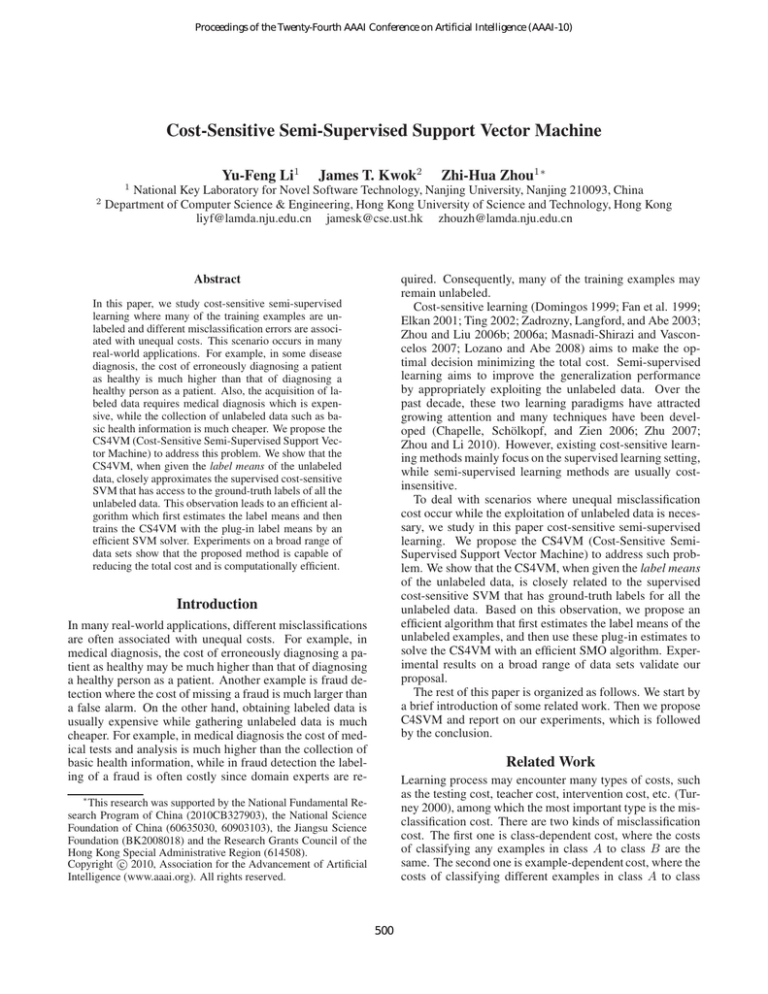
Proceedings of the Twenty-Fourth AAAI Conference on Artificial Intelligence (AAAI-10)
Cost-Sensitive Semi-Supervised Support Vector Machine
Yu-Feng Li1
James T. Kwok2
Zhi-Hua Zhou1∗
1
2
National Key Laboratory for Novel Software Technology, Nanjing University, Nanjing 210093, China
Department of Computer Science & Engineering, Hong Kong University of Science and Technology, Hong Kong
liyf@lamda.nju.edu.cn jamesk@cse.ust.hk zhouzh@lamda.nju.edu.cn
Abstract
quired. Consequently, many of the training examples may
remain unlabeled.
Cost-sensitive learning (Domingos 1999; Fan et al. 1999;
Elkan 2001; Ting 2002; Zadrozny, Langford, and Abe 2003;
Zhou and Liu 2006b; 2006a; Masnadi-Shirazi and Vasconcelos 2007; Lozano and Abe 2008) aims to make the optimal decision minimizing the total cost. Semi-supervised
learning aims to improve the generalization performance
by appropriately exploiting the unlabeled data. Over the
past decade, these two learning paradigms have attracted
growing attention and many techniques have been developed (Chapelle, Schölkopf, and Zien 2006; Zhu 2007;
Zhou and Li 2010). However, existing cost-sensitive learning methods mainly focus on the supervised learning setting,
while semi-supervised learning methods are usually costinsensitive.
To deal with scenarios where unequal misclassification
cost occur while the exploitation of unlabeled data is necessary, we study in this paper cost-sensitive semi-supervised
learning. We propose the CS4VM (Cost-Sensitive SemiSupervised Support Vector Machine) to address such problem. We show that the CS4VM, when given the label means
of the unlabeled data, is closely related to the supervised
cost-sensitive SVM that has ground-truth labels for all the
unlabeled data. Based on this observation, we propose an
efficient algorithm that first estimates the label means of the
unlabeled examples, and then use these plug-in estimates to
solve the CS4VM with an efficient SMO algorithm. Experimental results on a broad range of data sets validate our
proposal.
The rest of this paper is organized as follows. We start by
a brief introduction of some related work. Then we propose
C4SVM and report on our experiments, which is followed
by the conclusion.
In this paper, we study cost-sensitive semi-supervised
learning where many of the training examples are unlabeled and different misclassification errors are associated with unequal costs. This scenario occurs in many
real-world applications. For example, in some disease
diagnosis, the cost of erroneously diagnosing a patient
as healthy is much higher than that of diagnosing a
healthy person as a patient. Also, the acquisition of labeled data requires medical diagnosis which is expensive, while the collection of unlabeled data such as basic health information is much cheaper. We propose the
CS4VM (Cost-Sensitive Semi-Supervised Support Vector Machine) to address this problem. We show that the
CS4VM, when given the label means of the unlabeled
data, closely approximates the supervised cost-sensitive
SVM that has access to the ground-truth labels of all the
unlabeled data. This observation leads to an efficient algorithm which first estimates the label means and then
trains the CS4VM with the plug-in label means by an
efficient SVM solver. Experiments on a broad range of
data sets show that the proposed method is capable of
reducing the total cost and is computationally efficient.
Introduction
In many real-world applications, different misclassifications
are often associated with unequal costs. For example, in
medical diagnosis, the cost of erroneously diagnosing a patient as healthy may be much higher than that of diagnosing
a healthy person as a patient. Another example is fraud detection where the cost of missing a fraud is much larger than
a false alarm. On the other hand, obtaining labeled data is
usually expensive while gathering unlabeled data is much
cheaper. For example, in medical diagnosis the cost of medical tests and analysis is much higher than the collection of
basic health information, while in fraud detection the labeling of a fraud is often costly since domain experts are re-
Related Work
Learning process may encounter many types of costs, such
as the testing cost, teacher cost, intervention cost, etc. (Turney 2000), among which the most important type is the misclassification cost. There are two kinds of misclassification
cost. The first one is class-dependent cost, where the costs
of classifying any examples in class A to class B are the
same. The second one is example-dependent cost, where the
costs of classifying different examples in class A to class
∗
This research was supported by the National Fundamental Research Program of China (2010CB327903), the National Science
Foundation of China (60635030, 60903103), the Jiangsu Science
Foundation (BK2008018) and the Research Grants Council of the
Hong Kong Special Administrative Region (614508).
c 2010, Association for the Advancement of Artificial
Copyright Intelligence (www.aaai.org). All rights reserved.
500
Formulation
B are different. Generally the costs of different kinds of
misclassifications are given by the user, and in practice it is
much easier for the user to give class-dependent cost than
example-dependent cost. So, the former occurs more often
in real applications and has attracted more attention.
In this paper, we will focus on class-dependent cost. Existing methods for handling class-dependent costs mainly
fall into two categories. The first one is geared towards particular classifiers, like decision trees (Ting 2002), neural networks (Kukar and Kononenko 1998), AdaBoost (Fan et al.
1999), etc. The second one is a general approach, which
rescales (Elkan 2001; Zhou and Liu 2006a) the classes such
that the influences of different classes are proportional to
their costs. It can be realized in different ways, such as instance weighting (Ting 2002; Zhou and Liu 2006b), sampling (Elkan 2001; Zhou and Liu 2006b), threshold moving (Domingos 1999; Zhou and Liu 2006b), etc. Costsensitive support vector machines have also been studied
(Morik, Brockhausen, and Joachims 1999; Brefeld, Geibel,
and Wysotzki 2003; Lee, Lin, and Wahba 2004).
Many semi-supervised learning methods have been proposed (Chapelle, Schölkopf, and Zien 2006; Zhu 2007;
Zhou and Li 2010). A particularly interesting method is the
S3VM (Semi-Supervised Support Vector Machine) (Bennett
and Demiriz 1999; Joachims 1999). It is built on the cluster assumption and regularizes the decision boundary by exploiting the unlabeled data. Specifically, it favors decision
boundaries that go cross the low-density regions (Chapelle
and Zien 2005). The effect of its objective has been well
studied in (Chapelle, Sindhwani, and Keerthi 2008). Due to
the high complexity in solving the S3VM, many efforts have
been devoted to speeding up the optimization. Examples include local search (Joachims 1999), concave convex procedure (Collobert et al. 2006) and many other optimization
techniques (Chapelle, Sindhwani, and Keerthi 2008). Recently, (Li, Kwok, and Zhou 2009) revisits the formulation
of S3VM and shows that when given the class (label) means
of the unlabeled data, the S3VM is closely related to a supervised SVM that is provided with the unknown ground-truth
labels of all the unlabeled training data. This indicates that
the label means of the unlabeled data, which is a simpler
statistic than the set of labels of all the unlabeled patterns,
can be very useful in semi-supervised learning.
The use of unlabeled data in cost-sensitive learning has
been considered in a few studies (Greiner, Grove, and Roth
2002; Margineantu 2005; Liu, Jun, and Ghosh 2009; Qin
et al. 2008), most of which try to involve human feedback
on informative unlabeled instances and then refine the costsensitive model using the queried labels. In this paper, we
focus on using SVM to address unequal costs and utilize
unlabeled data simultaneously, by extending the approach
of (Li, Kwok, and Zhou 2009) to the cost-sensitive setting.
In cost-sensitive semi-supervised learning, we are given a
set of labeled data {(x1 , y1 ), · · · , (xl , yl )} and a set of unlabeled data {xl+1 , · · · , xl+u }, where y ∈ {±1}, l and u
are the numbers of labeled and unlabeled instances, respectively. Let Il = {1, · · · , l} and Iu = {l + 1, · · · , l + u}
be the sets of indices for the labeled and unlabeled data, respectively. Moreover, suppose the cost of misclassifying a
positive (or negative) instance is c(+1) (or c(−1)).
We first consider the simpler supervised learning setting.
Suppose that for each unlabeled pattern xi (i ∈ Iu ), we are
given the corresponding label ŷi . Then we can derive the
supervised cost-sensitive SVM (CS-SVM) (Morik, Brockhausen, and Joachims 1999) which finds a decision function
f (x) by minimizing the following functional:
X
X
1
ℓ(yi , f (xi )) + C2
ℓ(ŷi , f (xi )) ,
min kf k2H + C1
f 2
i∈Iu
i∈Il
(1)
where H is the reproducing kernel Hilbert space (RKHS)
induced by a kernel k and ℓ(y, f (x)) = c(y) max{0, 1 −
yf (x)} is the weighted hinge loss, C1 and C2 are regularization parameters trading off the complexity and empirical errors on the labeled and unlabeled data. The relation between
Eq. 1 and the Bayes rule has been discussed in (Brefeld,
Geibel, and Wysotzki 2003).
In semi-supervised setting, the labels ŷ = [ŷi ; i ∈ Iu ] of
the unlabeled data are unknown, and so need to be optimized
as well. This leads to the CS4VM:
X
X
1
ℓ(yi , f (xi ))+C2
ℓ(ŷi , f (xi )),
min min kf k2H +C1
ŷ∈B f 2
i∈Iu
i∈Il
(2)
where B = {ŷ|ŷi ∈ {±1}, ŷ′ 1 = r}, 1 is the all-one vector, and ŷ′ 1 = r (with the user-defined parameter r) is the
balance constraint which avoids the trivial solution that assigns all the unlabeled instances to the same class. Note that
the label ŷi should be as same as the sign 1 of the prediction
f (xi ), i.e., ŷi = sgn(f (xi )). Substituting this into Eq. 2, we
obtain the following optimization problem which no longer
involves the additional variable ŷ:
X
X
1
min kf k2H + C1
ℓ(yi , f (xi )) + C2
ℓ(ŷi , f (xi ))
f
2
i∈Iu
i∈Il
X
s.t.
sgn(f (xi )) = r, ŷi = sgn(f (xi )), ∀i ∈ Iu
(3)
i∈Iu
Figure 1 shows the loss function used for the unlabeled
data. When c(1) = c(−1), it becomes the standard symmetric hinge loss and CS4VM degenerates to TSVM (Joachims
1999). When c(1) 6= c(−1), however, the loss is no longer
continuous and many optimization techniques (Chapelle and
Zien 2005) could not be applied.
Label Means for CS4VM
CS4VM
Note that Eq. 3 involves the estimation of labels of all the unlabeled instances, which will be computationally inefficient
In this section, we first present the formulation of CS4VM
and show the usefulness of the label means in this context.
Then, an efficient learning algorithm will be introduced.
1
501
Here, we assume that sgn(0) = 1.
Eq.5 implies the objective in Eq.4 is only related to label
means. If we substitute the true label means m± into Eq. 4,
we have
X
1
min
kwk2 + C1
ℓ(yi , w′ xi + b) + C2 (1′ p+ + 1′ p− )
w,b,p± 2
i∈Il
′
−C2 w u+ c(+1)m+ − u− c(−1)m− − n1 + n2 b
s.t.
when the number of unlabeled instances is large. Motivated
by the observation in (Li, Kwok, and Zhou 2009) that the
label means offer a simpler statistic than the set of labels
on the unlabeled data, we will extend this observation to the
CS4VM. Moreover, we will see that the label means naturally decouple the cost and prediction, and the estimation is
also efficient.
+
′
Introducing additional variables p+ = [p+
ℓ+1 , . . . , pℓ+u ]
−
−
−
′
and p = [pℓ+1 , . . . , pℓ+u ] , we can rewrite the CS4VM as
the following:
X
X
1
min
kf k2H + C1
ℓ(yi , f (xi )) + C2
(p+
i
+
−
f,p ,p 2
s.t.
i
It is notable that Theorem 1 reduces to the results in (Li,
Kwok, and Zhou 2009) when c(1) = c(−1). The proof is
similar to (Li, Kwok, and Zhou 2009), and so will be omitted here. Figure 2 compares the loss in Eq.6 and the costsensitive hinge loss in CS-SVM on positive and negative examples.
i∈Iu
i∈Il
(6)
Eq. 6 is the CS4VM with known label means of the unlabeled data. The relation between Eq. 6 and the supervised
CS-SVM is stated by the following theorem.
Theorem 1. Suppose that f ∗ is the optimal solution of Eq. 6.
When all the unlabeled data do not suffer from large loss,
i.e., yi∗ f ∗ (xi ) ≥ −1, ∀i ∈ Iu , Eq. 6 is equivalent to the
CS-SVM. Otherwise, let ℓ̂(xi ) be the loss for the unlabeled
instance xi in Eq. 6. Then, ℓ̂(xi ) ≤ c(1)+c(−1)
ℓ(yi∗ , f (xi )).
c(y ∗ )
Figure 1: Loss function for the unlabeled data.
+p−
i
constraints in Eq. 4.
− c(sgn(f (xi )))(sgn(f (xi )f (xi ) − 1)))
c(+1)f (xi ) − c(+1) ≤ p+
i ,
(4)
−c(−1)f (xi ) − c(−1) ≤ p−
,
X i
−
sgn(f (xi )) = r .
p+
i , pi ≥ 0, ∀i ∈ Iu ;
i∈Iu
Proposition 1. Eq. 4 is equivalent to the CS4VM.
Proof. When 0 ≤ f (xi ) ≤ 1, both p±
i are zero and the loss
of xi is −c(+1)(f (xi ) − 1), which is equal to c(+1)(1 −
+
f (xi )) in Eq. 3. When f (xi ) ≥ 1, p−
i = 0 and pi =
c(+1)(f (xi ) − 1), and thus the overall loss is zero, which is
equal to CS4VM. A similar proof holds for f (xi ) < 0.
Figure 2: Loss in Eq. 6 and the cost-sensitive hinge loss in
CS-SVM. Here c(1) = 2 and c(−1) = 1.
Learning Algorithm
Analysis in the above section suggests that the label means
are useful for cost-sensitive semi-supervised support vector
machines. This motivates us to first estimate the label means
and then solve Eq. 6 with the estimated label means.
Let f (x) = w′ φ(x)+b, where φ(·) is the feature mapping
induced by the kernel k. As in (Li, Kwok, and Zhou 2009),
by using the balance constraint, the number of positive (resp.
negative) instances in the unlabeled data can be obtained as
u−r
u+ = r+u
2 (resp. u− = 2 ). Suppose that the ground-truth
label of the unlabeled instance xi is yi∗ . P
The label means
of the unlabeled data are then m+ = u1+ y∗ =1 φ(xi ) and
i
P
m− = u1− y∗ =−1 φ(xi ), respectively. Let n1 = c(1)u+ +
i
c(−1)u− and n2 = c(1)u+ − c(−1)u− . We have
X
c(sgn(f (xi )))(sgn(f (xi )f (xi ) − 1)) + n1
(5)
Estimating Label Means To estimate the label means, we
employ the large margin principle (Li, Kwok, and Zhou
2009) consistent with the CS4VM, i.e., maximizing the
margin between the means, which is also interpretable by
Hilbert space embedding of distributions (Gretton et al.
2006). Mathematically,
X
1
min minw,b,ρ
kwk2 + C1
ℓ(yi , w′ xi + b) − C2 ρ
d∈∆
2
i∈Il
P
i∈Iu di φ(xi )
+ b ≥ c(+1)ρ,
(7)
s.t.
w′
u+
P
i∈Iu (1 − di )φ(xi )
w′
+ b ≤ −c(−1)ρ , (8)
u−
i∈Iu
= c(1)
X
f (xi )≥0,i∈Iu
f (xi ) + c(−1)
X
−f (xi )
f (xi )<0,i∈Iu
w′ u+ c(+1)m̂+ − u− c(−1)m̂− + n2 b,
P
where m̂+ = u1+ i∈Iu ,f (xi )≥0 φ(xi ) (resp. m̂− =
P
1
i∈Iu ,f (xi )<0 φ(xi )) is an estimate of m+ (resp. m− ).
u−
=
where d = [di ; i ∈ Iu ] and ∆ = {d|di ∈ {0, 1}, d′1 =
u+ }. Note from Eqs. 7 and 8 that the class with the larger
502
Table 1: Comparison of total costs ((mean ± std.) ×103 ) in the first series of experiments (c(1) is randomly sampled from an
interval). The best performance (paired t-tests at 95% significance level) and its comparable results are bolded. The last line
shows the win/tie/loss counts of CS4VM versus other methods.
Data set
Supervised CS-SVM
Laplacian SVM
TSVM
CS4VM
GT CS-SVM
9.745 ± 6.906
17.02 ± 12.84
0.178 ± 0.388
3.955 ± 2.609
6.022 ± 6.451
23.63 ± 19.06
17.96 ± 13.44
5.772 ± 10.84
30.17 ± 22.28
8.594 ± 7.187
144.9 ± 87.03
9.919 ± 16.25
0.615 ± 1.188
4.094 ± 6.755
1.760 ± 1.505
4.976 ± 4.218
6.642 ± 6.881
1.978 ± 3.812
0.127 ± 0.125
3.404 ± 7.363
1.640 ± 2.708
27.19 ± 17.03
11.37 ± 17.29
1.314 ± 2.305
2.974 ± 5.514
25.01 ± 27.15
20.63 ± 14.88
6.162 ± 14.11
30.54 ± 26.16
9.693 ± 8.515
131.5 ± 81.30
119.3 ± 85.15
1.962 ± 6.346
5.748 ± 6.489
1.325 ± 1.415
7.207 ± 6.382
4.025 ± 4.177
18.70 ± 26.50
32.92 ± 38.52
6.968 ± 10.01
10.28 ± 6.985
11.98 ± 7.749
12.01 ± 7.844
4.129 ± 2.610
12.52 ± 8.384
24.80 ± 19.00
21.97 ± 14.26
32.08 ± 19.30
26.48 ± 18.83
12.50 ± 8.551
158.0 ± 90.43
74.90 ± 64.07
6.908 ± 4.770
2.512 ± 4.668
1.458 ± 1.479
0.943 ± 1.394
1.097 ± 1.951
7.191 ± 7.800
11.33 ± 8.367
2.122 ± 9.839
6.261 ± 4.920
7.811 ± 5.130
0.507 ± 1.018
3.576 ± 2.391
2.873 ± 2.533
15.98 ± 11.86
13.47 ± 9.942
10.01 ± 8.946
18.63 ± 13.30
6.206 ± 4.644
92.42 ± 52.09
16.14 ± 11.84
0.127 ± 0.205
0.045 ± 0.205
0.935 ± 1.061
0.420 ± 0.670
0.773 ± 1.197
1.002 ± 1.667
0.264 ± 0.415
2.521 ± 9.407
1.894 ± 1.836
5.036 ± 3.604
0.100 ± 0.005
0.982 ± 1.301
0.940 ± 1.056
3.263 ± 3.191
3.618 ± 2.631
0.249 ± 0.007
6.686 ± 5.029
1.804 ± 1.694
1.865 ± 1.789
1.131 ± 0.973
0.472 ± 0.852
0.000 ± 0.000
0.465 ± 0.618
0.198 ± 0.368
0.222 ± 0.538
0.378 ± 0.432
0.251 ± 0.479
0.646 ± 0.729
14/2/4
16/1/3
17/3/0
-
Heart-Statlog
Ionosphere
Live Disorder
Echocardiogram
Spectf
Australian
Clean1
Diabetes
German Credit
House Votes
Krvskp
Ethn
Heart
Texture
House
Isolet
Optdigits
Vehicle
Wdbc
Sat
CS4VM: W/T/L
are used in the experiments. Each data set is split into two
equal halves, one for training and the other for testing. Each
training set contains ten labeled examples. The linear kernel
is always used. Moreover, since there are too few labeled
examples for reliable model selection, all the experiments
are performed with fixed parameters: C1 and C2 are fixed
at 1 and 0.1, respectively, while u+ and u− are obtained as
the ratios of positive and negative examples in the labeled
training data.
Two different cost setups are considered:
misclassification cost is given a larger weight in margin
computation. Moreover, unlike the formulation of Eq. 3,
the optimization problem is now much easier since there are
only two constraints corresponding to the unlabeled data,
and the misclassification costs do not couple with the signs
of the predictions. Indeed, as in (Li, Kwok, and Zhou 2009),
it can be solved by an iterative procedure that alternates between two steps. We first fix d and solve for {w, b, ρ} via
standard SVM training, and then fix {w, b, ρ} and solve for
d via a linear program.
Solving Eq. 6 with Estimated Label Means After obtaining
d, the label means can be P
estimated as m+ =
1
1 P
d
φ(x
)
and
m
=
i
i
−
i∈Iu
i∈Iu (1 − di )φ(xi ).
u+
u−
Note that in Eq. 6, the constraints are linear and the objective is convex, and thus it is a convex optimization problem.
By introducing Lagrange multipliers α = [αi ; i ∈ Il ] and
β ± = [βi± ; i ∈ Iu ] for the constraints in Eq. 6, its dual can
be written as
X
X
1
max±
αi −
(c(1)βi+ + c(−1)βi− ) − kwk2
2
α,β
i∈Il
i∈Iu
X
X
s.t.
αi yi −
(c(1)βi+ − c(−1)βi− ) = 0,
(9)
i∈Il
1. c(−1) is fixed at 1 while c(1) is chosen randomly from
a uniform distribution on the interval [0, 1000]. Each experiment is repeated for 100 times and then the average
results are reported. From this series of experiments we
can see how an approach is robust to different costs.
2. c(−1) is fixed at 1 while c(1) is set to 2, 5 and 10, respectively. For each value of c(1), the experiment is repeated for 30 times and then the average results are reported. From this series of experiments we can see how
the performance of an approach changes as the cost varies.
We compare CS4VM with the following approaches: 1)
A supervised CS-SVM using only the labeled training examples; 2) A supervised CS-SVM (denoted by GT CSSVM) using the labeled training examples and all the unlabeled data with ground-truth labels; 3) Two state-of-theart semi-supervised learning methods, that is, the Laplacian
SVM (Belkin, Niyogi, and Sindhwani 2006) and TSVM
(Joachims 1999). These two methods are cost-blind, and in
the experiments we extend them for cost-sensitive learning
by incorporating the misclassification cost for each labeled
training example as in the CS-SVM, while the costs of the
unlabeled data are difficult to incorporate. All the compared
approaches are implemented in MATLAB 7.6, and experic
ments are run on a 2GHz Xeon
2 Duo PC with 4GB mem-
i∈Iu
0 ≤ αi ≤ c(yi )C1 , ∀i ∈ Il ; 0 ≤ βi± ≤ C2 , ∀i ∈ Iu ,
P
where w = u+ c(1)m+ − u− c(−1)m− + i∈Il αi yi xi +
P
−
+
i∈Iu (−c(1)βi +c(−1)βi )xi . Eq. 9 is a convex quadratic
program (QP) with one linear equality constraint. This is
similar to the dual of standard SVM and can be efficiently
handled by state-of-the-art SVM solvers, like LIBSVM using the SMO algorithm.
Experiments
In this section, we empirically evaluate the performance of
the proposed CS4VM. A collection of twenty UCI data sets
503
Table 2: Comparison of total costs (mean ± std.) in the second series of experiments (c(1) is set to different fixed values).
The best performance (paired t-tests at 95% significance level) and its comparable results are bolded. The last line shows the
win/tie/loss counts of CS4VM versus other methods.
Cost ratio
Data set
Supervised CS-SVM
Laplacian SVM
TSVM
CS4VM
GT CS-SVM
2
House votes
Clean1
Australian
German Credit
Krvskp
Heart-statlog
Diabetes
Ionosphere
Liver Disorders
Echocardiogram
Spectf
Heart
House
Wdbc
Isolet
Optdigits
Texture
Vehicle
Ethn
Sat
39.76 ± 10.90
131.6 ± 21.08
136.0 ± 44.93
276.7 ± 27.39
848.4 ± 172.6
54.23 ± 12.36
236.3 ± 30.57
79.96 ± 23.11
99.83 ± 4.653
23.76 ± 4.513
88.90 ± 14.82
67.46 ± 12.58
14.06 ± 4.945
102.6 ± 8.082
34.10 ± 17.07
44.30 ± 22.93
15.76 ± 17.61
78.00 ± 17.85
654.9 ± 44.58
44.23 ± 75.91
47.47 ± 20.77
141.2 ± 20.70
170.4 ± 63.79
286.4 ± 31.74
856.3 ± 141.2
59.33 ± 11.71
241.9 ± 17.60
112.5 ± 14.76
114.0 ± 21.31
44.76 ± 11.69
104.0 ± 11.97
69.10 ± 12.27
12.98 ± 6.523
139.6 ± 101.5
37.64 ± 18.77
29.64 ± 16.52
23.81 ± 18.96
96.45 ± 51.04
612.3 ± 129.5
30.99 ± 33.22
58.04 ± 15.41
144.7 ± 23.35
132.3 ± 53.56
268.2 ± 45.57
936.3 ± 188.7
54.96 ± 14.57
220.4 ± 45.40
71.40 ± 23.47
114.9 ± 14.81
20.90 ± 4.932
82.10 ± 16.56
48.69 ± 14.30
12.78 ± 5.772
57.65 ± 14.37
4.322 ± 4.373
6.592 ± 7.123
9.582 ± 13.15
47.43 ± 26.61
525.1 ± 299.4
12.85 ± 36.43
37.96 ± 11.63
132.1 ± 21.43
120.8 ± 40.37
275.0 ± 28.82
794.7 ± 143.8
54.43 ± 13.21
196.4 ± 43.38
68.40 ± 23.79
105.2 ± 11.56
23.86 ± 4.383
86.03 ± 16.12
49.83 ± 12.08
12.06 ± 5.782
52.13 ± 10.24
5.000 ± 4.202
14.96 ± 15.13
0.262 ± 0.980
53.00 ± 18.07
499.3 ± 105.0
32.83 ± 76.55
21.80 ± 4.160
57.56 ± 7.620
82.63 ± 9.752
196.6 ± 8.840
59.10 ± 8.601
33.86 ± 5.912
136.3 ± 8.844
39.36 ± 6.262
96.86 ± 5.811
21.66 ± 5.282
50.06 ± 6.103
34.60 ± 4.432
5.102 ± 1.931
20.13 ± 4.522
1.864 ± 1.473
1.900 ± 1.903
0.000 ± 0.000
12.86 ± 3.414
64.23 ± 8.137
4.363 ± 2.203
CS4VM: W/T/L
House-votes
Clean1
Australian
German Credit
Krvskp
Heart-statlog
Diabetes
Ionosphere
Liver Disorders
Echocardiogram
Spectf
Heart
House
Wdbc
Isolet
Optdigits
Texture
Vehicle
Ethn
Sat
8/11/1
85.00 ± 28.66
231.4 ± 56.70
282.3 ± 106.6
464.4 ± 76.69
1717. ± 481.4
112.0 ± 31.17
264.0 ± 49.27
176.7 ± 62.76
100.3 ± 5.472
51.26 ± 13.85
112.7 ± 40.97
73.00 ± 10.77
24.66 ± 11.89
103.1 ± 8.332
73.00 ± 45.70
81.52 ± 39.44
34.96 ± 44.35
89.33 ± 21.33
716.4 ± 116.8
61.83 ± 95.10
15/5/0
90.46 ± 49.69
257.8 ± 46.66
292.4 ± 133.4
488.4 ± 120.6
1714. ± 423.4
67.33 ± 17.26
313.9 ± 119.2
277.3 ± 35.80
184.0 ± 116.6
50.76 ± 8.492
122.9 ± 27.43
80.77 ± 32.86
20.92 ± 13.31
323.0 ± 273.2
83.81 ± 47.96
51.66 ± 27.75
59.42 ± 47.51
194.2 ± 151.8
1331. ± 394.2
72.00 ± 84.99
6/14/0
127.2 ± 34.13
269.5 ± 53.75
251.8 ± 86.41
462.9 ± 85.49
1757. ± 345.2
115.3 ± 32.11
431.0 ± 115.4
151.0 ± 50.13
220.0 ± 28.21
45.26 ± 11.18
152.5 ± 37.51
92.24 ± 33.03
20.77 ± 11.98
123.5 ± 38.57
9.612 ± 10.06
13.22 ± 15.80
23.37 ± 33.06
92.49 ± 65.53
964.4 ± 615.7
22.97 ± 72.02
72.03 ± 25.43
209.6 ± 41.24
231.0 ± 76.42
406.4 ± 63.33
1364. ± 282.2
96.26 ± 28.45
338.9 ± 108.9
128.3 ± 32.24
105.6 ± 16.21
49.90 ± 13.58
104.4 ± 32.86
68.60 ± 7.612
19.26 ± 10.81
70.96 ± 12.59
16.23 ± 15.03
28.90 ± 25.11
1.000 ± 3.472
74.56 ± 23.29
717.7 ± 142.2
59.36 ± 131.9
34.60 ± 9.742
83.13 ± 12.39
117.9 ± 15.86
294.4 ± 21.13
73.23 ± 15.83
59.50 ± 11.25
178.0 ± 10.94
82.72 ± 12.64
99.60 ± 4.432
31.90 ± 6.213
62.10 ± 11.18
54.43 ± 9.004
8.463 ± 4.025
27.93 ± 5.154
3.462 ± 3.334
3.264 ± 4.362
0.000 ± 0.000
19.36 ± 3.743
82.33 ± 12.52
9.736 ± 5.952
CS4VM: W/T/L
House-votes
Clean1
Australian
German Credit
Krvskp
Heart-statlog
Diabetes
Ionosphere
Liver Disorders
Echocardiogram
Spectf
Heart
House
Wdbc
Isolet
Optdigits
Texture
Vehicle
Ethn
Sat
10/9/1
159.0 ± 58.43
397.8 ± 120.5
526.2 ± 213.0
777.2 ± 174.6
3167. ± 1006.
207.9 ± 63.73
314.8 ± 120.5
340.9 ± 130.5
101.2 ± 7.602
87.30 ± 28.80
181.2 ± 92.48
79.00 ± 19.27
42.33 ± 24.38
103.1 ± 8.332
137.8 ± 94.81
143.5 ± 77.71
66.96 ± 90.05
108.0 ± 39.93
829.1 ± 327.2
91.16 ± 136.9
14/5/1
175.5 ± 98.15
454.3 ± 97.13
519.6 ± 278.7
818.4 ± 314.5
3096. ± 899.9
80.66 ± 33.70
433.9 ± 319.3
552.0 ± 72.84
300.7 ± 276.4
60.76 ± 21.91
154.4 ± 75.98
91.66 ± 46.03
32.46 ± 30.19
627.2 ± 530.2
176.1 ± 96.36
88.03 ± 48.97
109.7 ± 99.07
347.0 ± 345.6
2580. ± 828.5
140.8 ± 173.7
13/5/2
248.6 ± 67.70
479.2 ± 101.1
478.4 ± 159.7
767.6 ± 157.4
3193. ± 628.5
214.3 ± 63.80
776.2 ± 210.0
284.0 ± 93.76
363.6 ± 60.11
84.36 ± 25.79
280.4 ± 72.72
147.6 ± 52.63
35.26 ± 17.56
208.0 ± 75.69
20.83 ± 24.49
28.62 ± 40.95
28.53 ± 37.92
178.7 ± 122.1
1841. ± 1125.
20.06 ± 11.55
127.7 ± 45.23
340.3 ± 76.87
395.3 ± 128.7
600.7 ± 119.3
2264. ± 524.2
160.5 ± 55.56
489.4 ± 181.0
219.2 ± 57.97
109.5 ± 23.97
83.96 ± 27.76
130.0 ± 40.54
75.53 ± 6.982
29.20 ± 15.87
80.23 ± 12.58
32.56 ± 21.77
44.73 ± 30.55
2.402 ± 6.093
88.10 ± 33.03
925.0 ± 183.7
97.40 ± 205.2
49.50 ± 13.52
116.2 ± 26.84
158.0 ± 34.83
389.3 ± 56.62
88.66 ± 23.40
76.20 ± 22.79
247.2 ± 12.74
130.7 ± 30.01
99.60 ± 4.432
48.70 ± 12.06
67.50 ± 13.84
71.53 ± 8.523
13.13 ± 8.062
34.93 ± 9.226
6.302 ± 6.693
5.464 ± 8.763
0.000 ± 0.000
26.83 ± 5.722
102.8 ± 16.59
17.86 ± 11.71
14/5/1
13/5/2
15/4/1
-
5
10
CS4VM: W/T/L
ory and Vista system.
Table 1 summarizes results of the first series of experiments. It can be seen that CS4VM usually outperforms
the cost-sensitive extensions of Laplacian SVM and TSVM.
Specifically, Paired t-tests at 95% significance level show
that CS4VM achieves 16 wins, 1 tie and 3 losses when compared to Laplacian SVM; and 17 wins, 3 ties and 0 loss when
compared to TSVM. Wilcoxon sign tests at 95% significance level show that CS4VM is always significantly better
than all the other three approaches, while Laplacian SVM
504
low density separation. In Proc. 10th Int’l Workshop AI and Stat.,
57–64.
Chapelle, O.; Schölkopf, B.; and Zien, A., eds. 2006. SemiSupervised Learning. Cambridge, MA: MIT Press.
Chapelle, O.; Sindhwani, V.; and Keerthi, S. S. 2008. Optimization
techniques for semi-supervised support vector machines. J. Mach.
Learn. Res. 9:203–233.
Collobert, R.; Sinz, F.; Weston, J.; and Bottou, L. 2006. Large
scale transductive SVMs. J. Mach. Learn. Res. 7:1687–1712.
Domingos, P. 1999. MetaCost: A general method for making
classifiers cost-sensitive. In Proc. 5th ACM SIGKDD Int’l Conf.
Knowl. Disc. Data Min., 155–164.
Elkan, C. 2001. The foundations of cost-sensitive learning. In
Proc. 17th Int’l Joint Conf. Artif. Intell., 973–978.
Fan, W.; Stolfo, S. J.; Zhang, J.; and Chan, P. K. 1999. AdaCost:
Misclassification cost-sensitive boosting. In Proc. 16th Int’l Conf.
Mach. Learn., 97–104.
Greiner, R.; Grove, A. J.; and Roth, D. 2002. Learning costsensitive active classifiers. Artif. Intell. 139(2):137–174.
Gretton, A.; Borgwardt, K. M.; Rasch, M.; Schölkopf, B.; and
Smola, A. J. 2006. A kernel method for the two-sample-problem.
In Adv. Neural Infor. Process. Syst. 19. 513–520.
Joachims, T. 1999. Transductive inference for text classification
using support vector machines. In Proc. 16th Int’l Conf. Mach.
Learn., 200–209.
Kukar, M., and Kononenko, I. 1998. Cost-sensitive learning with
neural networks. In Proc. 13th Eur. Conf. Artif. Intell., 445–449.
Lee, Y.; Lin, Y.; and Wahba, G. 2004. Multicategory support
vector machines: Theory and application to the classification of
microarray data and satellite radiance data. J. Ame. Stat. Assoc.
99(465):67–82.
Li, Y.-F.; Kwok, J. T.; and Zhou, Z.-H. 2009. Semi-supervised
learning using label mean. In Proc. 26th Int’l Conf. Mach. Learn.,
633–640.
Liu, A.; Jun, G.; and Ghosh, J. 2009. Spatially cost-sensitive active
learning. In Proc. 9th SIAM Int’l Conf. Data Min., 814–825.
Lozano, A. C., and Abe, N. 2008. Multi-class cost-sensitive boosting with p-norm loss functions. In Proc. 14th ACM SIGKDD Int’l
Conf. Knowl. Disc. Data Min., 506–514.
Margineantu, D. D. 2005. Active cost-sensitive learning. In Proc.
19th Int’l Joint Conf. Artif. Intell., 1622–1623.
Masnadi-Shirazi, H., and Vasconcelos, N. 2007. Asymmetric
boosting. In Proc. 24th Int’l Conf. Mach. Learn., 619–626.
Morik, K.; Brockhausen, P.; and Joachims, T. 1999. Combining statistical learning with a knowledge-based approach: A case
study in intensive care monitoring. In Proc. 16th Int’l Conf. Mach.
Learn., 268–277.
Qin, Z.; Zhang, S.; Liu, L.; and Wang, T. 2008. Cost-sensitive
semi-supervised classification using CS-EM. In Proc. 8th Int’l
Conf. Comput. Infor. Tech., 131–136.
Ting, K. M. 2002. An instance-weighting method to induce costsensitive trees. IEEE Trans Knowl. Data Eng. 14(3):659–665.
Turney, P. 2000. Types of cost in inductive concept learning. In
ICML Workshop Cost-Sensitive Learning, 15–21.
Zadrozny, B.; Langford, J.; and Abe, N. 2003. Cost-sensitive
learning by cost-proportionate example weighting. In Proc. 3rd
IEEE Int’l Conf. Data Min., 435–442.
Zhou, Z.-H., and Li, M. 2010. Semi-supervised learning by disagreement. Knowl. Infor. Syst.
Zhou, Z.-H., and Liu, X.-Y. 2006a. On multi-class cost-sensitive
learning. In Proc. 21st Nat’l Conf. Artif. Intell., 567–572.
Zhou, Z.-H., and Liu, X.-Y. 2006b. Training cost-sensitive neural
networks with methods addressing the class imbalance problem.
IEEE Trans Knowl. Data Eng. 18(1):63–77.
Zhu, X. 2007. Semi-supervised learning literature survey. Technical report, Department of Computer Science, University of
Wisconsin-Madison.
Table 3: Running time in seconds (n is the size of data).
(Data, n)
(Heart,270)
(Wdbc,569)
(Australian,690)
(Optdigits,1143)
(Ethn,2630)
(Sat,3041)
(Krvskp,3196)
Laplacian SVM
0.13 ± 0.23
0.32 ± 0.34
0.26 ± 0.31
0.49 ± 0.37
3.16 ± 0.76
4.50 ± 1.05
5.92 ± 1.11
TSVM
1.44 ± 0.04
4.69 ± 0.07
4.27 ± 0.09
28.39 ± 0.08
46.42 ± 0.44
63.73 ± 0.34
11.76 ± 0.11
CS4VM
0.09 ± 0.04
0.20 ± 0.03
0.12 ± 0.04
0.18 ± 0.05
0.66 ± 0.04
1.01 ± 0.06
1.01 ± 0.05
and TSVM are not significantly better than the supervised
CS-SVM. Moreover, CS4VM often benefits from the use of
unlabeled data (on 14 out of the 20 data sets), while Laplacian SVM yields performance improvements on only five
data sets and TSVM improves on only three data sets. Even
for the few data sets (such as Wdbc) on which the unlabeled
data do not help (possibly because the cluster assumption
and manifold assumption do not hold), CS4VM does not increase the cost relative to the supervised CS-SVM by three
times, while the cost-sensitive versions of Laplacian SVM
and TSVM may increase the cost by more than 10 times.
Table 2 summarizes results of the second series of experiments. Similar to results in the first series of experiments,
CS4VM usually outperforms the other approaches, and the
cost-sensitive extensions of Laplacian SVM and TSVM are
not effective in cost reduction. As the cost ratio increases,
the advantage of CS4VM becomes more prominent.
Table 3 compares the running time costs of CS4VM and
the cost-sensitive extensions of Laplacian SVM and TSVM.
Results are averaged over all the settings reported in Tables 1
and 2. Due to the page limit, only results on seven representative data sets are shown. As can be seen, CS4VM is more
efficient than the compared approaches.
Conclusion
In this paper, we propose CS4VM (Cost-Sensitive SemiSupervised Support Vector Machine) which considers unequal misclassification costs and the utilization of unlabeled
data simultaneously. This is a cost-sensitive extension of
the approach in (Li, Kwok, and Zhou 2009) where an efficient algorithm for exploiting unlabeled data in support vector machine is developed based on the estimation of label
means of unlabeled data. Experiments on a broad range of
data sets show that CS4VM has encouraging performance,
in terms of both the cost reduction and computational efficiency. The current work focuses on two-class problems.
Extending CS4VM to multi-class scenario and other types
of costs are interesting future issues.
References
Belkin, M.; Niyogi, P.; and Sindhwani, V. 2006. Manifold regularization: A geometric framework for learning from labeled and
unlabeled examples. J. Mach. Learn. Res. 7:2399–2434.
Bennett, K., and Demiriz, A. 1999. Semi-supervised support vector
machines. In Adv. Neural Infor. Process. Syst. 11. 368–374.
Brefeld, U.; Geibel, P.; and Wysotzki, F. 2003. Support vector
machines with example dependent costs. In Proc. 14th Eur. Conf.
Mach. Learn., 23–34.
Chapelle, O., and Zien, A. 2005. Semi-supervised learning by
505




